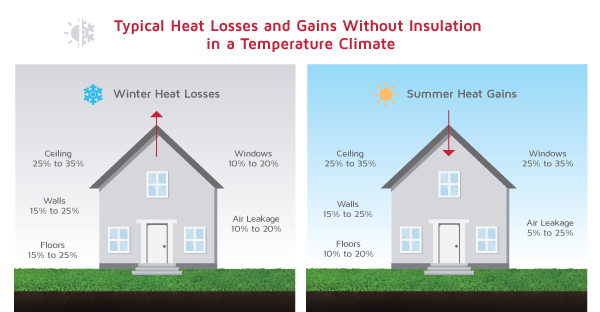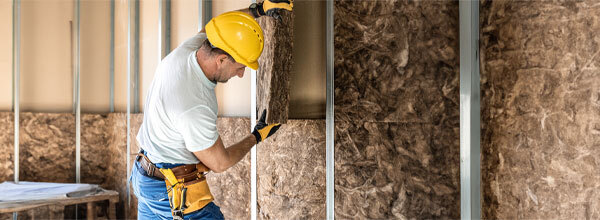Insulation is material designed to decrease the amount of heat entering from outside when it’s hot and traps warmth inside when it’s cold. Having your home well-insulated is key to keeping the temperature comfortable and your energy bills low. Many homeowners aren’t aware they have insufficient insulation and the impact it can have on their lives.
How Does Insulation Work?
Insulation slows down the transfer of heat. Heat moves in three ways: conduction (passes directly through materials), convection (moves through liquids/gasses like warm air rising) and radiation (moves in waves, like from the sun). Insulation materials have air pockets that trap heat, making it harder for it to move through. Having proper insulation means your heating and cooling systems don’t have to work as hard to keep your home at a comfortable temperature, which saves you money and helps the environment.
Why is Insulation Important?
Energy savings: Insulation allows less heat to escape in winter and enter in the summer, making heaters and air conditioners more efficient. By using less energy, you can save up to 45% on heating and cooling costs. Improving your insulation can make a difference in your home’s energy performance and carbon footprint.
Comfort: Insulation helps maintain a consistent temperature year-round, making your home more comfortable. It can also help reduce the humidity and keep pollen, dust and insects out of your home.
Reduced noise: Having insulation absorbs noise, which can make your home quieter.
Resale value: Lowering your home’s operating costs can be a great selling point and increases your property’s value.
Insulation is rated in terms of its thermal resistance or R-value. The higher the R-value, the greater the insulating effectiveness. R-value measures how resistant insulation is based on the type, thickness and density of the material. The Department of Energy recommends different insulation levels based on your region to increase energy efficiency.
Most Common Types of Insulation
Fiberglass (the most common insulation material) is made from fine glass fibers. It comes in batts, rolls or loose-fill forms and is usually used in sidewalls, attics, crawl spaces, cathedral ceilings and basements. When working with this material, always wear protective gear and clothing as it’s a skin and lung irritant.
Mineral Wool (also called rock or slag wool) is made from rock, blast furnace slag and other raw materials that are melted and spun into fibers to resemble wool. It comes in batts, rolls and loose fill. Like fiberglass, it is also used in sidewalls, attics, floors, crawl spaces, cathedral ceilings and basements.
Cellulose insulation is made from recycled paper products or wood. It is chemically treated with borate to resist fire and insects. It is usually in loose-fill form.
Spray foam is made from types of plastic (polystyrene, polyisocyanurate or polyurethane) and mixed to create foam and is then applied with a sprayer in attics and wall cavities. There are two types: open cell foam and closed cell foam.
Forms of Insulation
Loose fill (or blown in) is sprayed into place with special equipment and is one of the best types of insulation for attics since it covers hard-to-reach areas.
Batt is a type of installation blanket that comes in pre-cut sections and is best for unfinished walls, floors and ceilings.
Rolled is similar to batt insulation but it comes in rolls instead of in pre-cut sections. It can be more effective than batts because it covers the gaps between sections better.
Foam boards (or insulating boards) are hard panels that can be used almost anywhere in your home due to its high R-value. They are best for floors, foundation and basement walls, interior and exterior wall sheathing and low-sloped ceilings.
Spray foam expands and hardens to fill in the gaps and is best for hard-to-reach areas and sealing around doors, windows and vents. It is a good choice for colder climates and is typically more expensive than other options.
Radiant barriers reflect heat away from your home instead of reducing the flow of heat out of your home. It’s best for attics, unfinished walls, ceilings, floors and attached garages in hot climates.
Vapor barriers prevent water vapor from passing into your walls and ceilings during cold weather. It’s best for interior and exterior walls in cold or humid climates due to the increase in moisture.
Signs Your Home is Under-Insulated
Inconsistent temperatures: If your kitchen is cold and your living room is warm, that’s a sign your house may not be properly insulated.
High energy bills: If your energy bills have increased over the last few years, your insulation may have settled, making it less effective. If wasted heat is escaping through your roof and walls, it may be time to replace your insulation.
Cold walls, floors and ceilings: They should feel warm and dry, if they feel damp or cold, there’s not enough insulation.
Chilly drafts: During the winter, drafts in some areas of your home are from cool air entering through windows and doors. Having extra insulation in these areas will decrease the drafts. It will also save on your energy bills.
Water leaks in the attic: If you’re experiencing a leaky attic, your insulation could be part of the problem. Leaks can cause water damage, which can be costly to fix.
Ice damns: They occur when heat melts the bottom layer of snow off your roof, tickles down to your gutters and freeze when it hits the cooler air. This happens when the heat is rising from a poorly insulated home and large chunks of ice and icicles are formed.
Frozen pipes: Under-insulated walls can cause frozen pipes that can burst, which can cost thousands of dollars’ worth of damage.

Many older homes have less insulation than homes built today, but by adding more insulation you can reduce your energy bills. To find out if you should add insulation, you need to find out how much insulation you already have in your home and where it is located. A qualified home energy assessor will include an insulation check as a routine part of an energy assessment. An energy assessment, or home energy audit, will also help identify areas of your home that need air sealing. Before you insulate, you should make sure that your home is properly air sealed.
To learn more about your options or schedule an appointment, contact your local Lennox Dealer.

